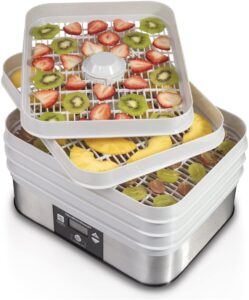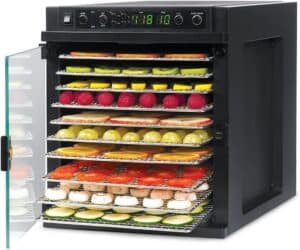Food dehydrators have become popular electrical devices in most modern kitchens. In most homes, family members have enjoyed preserving their favorite food using them. Market to and fro hurry, buying frozen and canned meals has become a story of the past.
People have saved money over time and also reduced home waste since excess food can be preserved for later use. Unlike in the past, perishable food such as vegetables, meat, and fish can no longer be spread out for sun drying. A more reliable and efficient device has come to replace such and other traditional methods of food preservation. It is worth noting that varieties of dehydrators vary from each other depending on their airflow systems. The two major types are horizontal airflow and vertical airflow dehydrators. You can opt to purchase any of the two depending on their functionality.
Read More: How to Use Food Dehydrator For Maintaining Healthy Lifestyle
Table of Contents
Vertical-Flow Food Dehydrator

How Vertical-Flow Dehydrator Works
Notably, the working of different brands of vertical-flow dehydrators varies in some respects. But most of them have great working similarities. In this dehydrator, the hot air moves from the bottom of the unit to the top and vice-versa. The hot air that moves vertically and downwards via a fan-heater unit and spreads through stacked trays dehydrates food. Depending on the position of the source of hot air, the tray near the fan dries better than other trays far from it. For this reason, it is challenging to achieve even dehydration of food in the other trays.
Strength of Vertical-Flow Dehydrator Construction
- You can expand this food dehydrator by adding more trays to dry a large amount of food at a go.
- Most models of these dehydrators are affordable.
- It does not take up ample kitchen space since it is compact and small.
- The model is suitable for delicate foodstuff like herbs.
- They are sold in different shapes, which a customer can choose from.
Weaknesses of Vertical-Flow Dehydrator Construction
- Not suitable for some food which requires a lot of heat like meat.
- It requires frequent checking and tray rotation.
- It leads to the mixing of food flavors due to the vertical movement of hot air.
Horizontal-Flow Dehydrator

How Horizontal-Flow Dehydrator Works
Since the heat source of this model is at the rear panel, the hot air flows from the backside to the front end of the unit via food trays. The fan of this dehydrator blows hot air uniformly across the horizontal trays where the food is. Food in all the trays receives heat evenly; hence frequent inspection is not very essential. Some dehydrators of this kind have two fans for uniform and better spreading of hot air.
Strength of Horizontal-Flow Food Dehydrator Construction
- It is hassle-free and easy to use.
- It is suitable for dehydrating hard food like jerky meat and fish.
- Unlike vertical-flow dehydrators, food particles cannot enter the fans.
- Provide a larger drying space.
- Food flavors are least likely to mix.
Weaknesses of Horizontal-Flow Dehydrator Construction
- One cannot add more trays to expand it.
- It is larger and less compact hence taking more counter space.
- It is more expensive compared to the vertical-flow dehydrator.
Food Dehydrators with Temperature Control
Some food dehydrators feature the thermostat, while some usually basic ones come without a temperature control system. However, it is an essential feature because different food types require a specific temperature for efficient dehydration.
Most of the dehydrator’s thermostats have a temperature range of 90ᵒF-160ᵒF. The thermostats allow the user to choose the temperature to use depending on the food type to dry. For instance, delicate herbs require a lower temperature ranging from 90ᵒ F‑100ᵒF, while meat requires a higher temperature of up to 160ᵒF. Setting the temperature at a high range while drying meat ensures effective control of pathogens and bacteria in the meat. Dehydrating fruits and vegetables at a lower temperature range (125–140 degrees Fahrenheit) preserves enzymes and nutrients which are highly sensitive to high temperatures.
Besides, the thermostat is an essential feature for raw foodist users. Because the raw food preserves the enzymes and nutritional values of raw food if it is dehydrated at a temperate below 46 F. Even if your dehydrator has an accurate dehydrating thermometer, this category of food dehydrator users confirm the temperature using a digital thermometer.
Dehydrators With Timer
The Timer is another feature that is not present in all food dehydrator models. Versions of dehydrators with a timer can be handy, especially for people who are occupied most of the time. A timer will automatically switch off the dehydrator in their absence. Most timer versions have an hour range of 12–99 hours. On the other hand, it is vital to note that the timer may not always be accurate since other factors influence the dehydration of food. Therefore, you should be very conversant and familiar with the duration at which specific food items will take to dehydrate.
Electricity Consumption
Generally, electricity consumption can vary much among different food dehydrator models. The total power usage of most home dehydrators ranges from 300 to 1000 Watts. Besides, other factors can determine their power consumption. For instance, the surrounding environment will determine the level of this rate. If your dehydrator is running in icy surroundings during a cold season, it may end up consuming slightly more power. This can be due to the cooling effect of wind or humidity in the environment. However, a dehydrator running in warm surroundings will consume slightly less electrical power. The other factor is the size and the amount of humidity of the batch in the dehydrator. A large humid batch may require slightly more energy to dry. Both the number and the size of fans of a model can also determine power consumption.
Noise Level
Due to the presence of a fan/fans in a dehydrator, noise is a typical factor to consider before purchasing a dehydrator. A quieter dehydrator is an essential option for those who are more sensitive to loud sounds or those living in noise-sensitive areas. Less noisy models will be of great help to those with limited space in their homes since they might not have extra room to store it. Additionally, noisy models can be kept in the laundry room or the garage.
Summary
Whenever you decide to purchase a dehydrator, it is wise to consider the above factors to enable you to pick one that suits your needs. For example, you can select a vertical-flow dehydrator if you need to dehydrate delicate herbs or if you have limited space in your room. Also, check on factors like a timer-version dehydrator or even the price. Depending on where you live or your noise sensitivity, you can choose one that fits your environment’s noise tolerance. You are guaranteed the most excellent model according to your desire by considering such factors.



